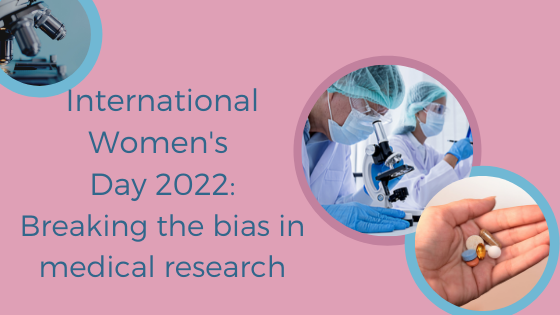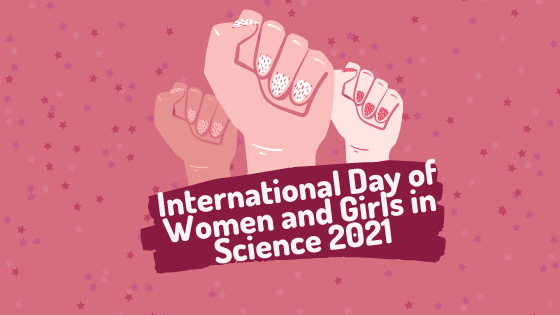International Women’s Day (IWD) takes place annually on 8th March, and this year’s theme is #BreakTheBias. With this in mind, we thought we’d explore the bias against women in medical research. Why are women’s health issues not taken as seriously as they should be, and what can be done about it?
Historical reasons for the medical bias against women
To understand the reasons why women are underrepresented in medical research, we first have to look at the historical context. The 1960s thalidomide tragedy led to a precautionary ban on pregnant individuals and women of childbearing age from entering into clinical trials.1 Researchers have also been concerned about the effect of fluctuating hormone levels in people who menstruate and whether this could impact clinical trial results.2
This issue goes back much further, however; since the dawn of time, women’s bodies have been thought of as inferior to the bodies of men, as seen in the views of Ancient Greek philosophers and the pioneers of early medicine:
- “…within the human, the man is more perfect than the woman, and the reason for his perfection is his greater heat, for heat is the first instrument of nature” – Galen, 2nd Century (AD) Greek physician3
- Aristotle described women as “incomplete males” (and even believed they had fewer teeth than men)4
- “When [the uterus] has remained sterile for a long time after having passed the suitable age, this organ becomes impatient; it does not accept this state, and because it begins to wander throughout the body” – Plato, 5th Century (BCE) Greek philosopher3
What we can see from these early ideas is a clear distinction between male bodies as “ideal” and women’s bodies as “lesser”. What’s also interesting is the emphasis on reproduction as the primary goal of the female body, which sadly, prevails to some extent in the 21st Century. With such extreme bias against women deeply rooted in the foundations of medicine, perhaps it’s no surprise that we still see such views, whether intentional or not, to this day.
Inclusion of women in clinical trials

Despite efforts made by regulatory bodies to increase gender diversity in clinical trials, women remain largely underrepresented, with some estimates indicating as little as 22% of participants in phase I trials are female.1 Current guidelines recommend that women should be represented in studies in proportion to their risk of certain diseases, however, this target is not being met in research for conditions such as cardiovascular disease and certain forms of cancer. An example is seen in the case of erdafitinib, a drug approved by the FDA in 2018 for bladder cancer. Women made up only 21% of the trial participants, a figure justified by the fact that men are more likely to be diagnosed with the disease. Women, however, tend to have poorer survival outcomes with bladder cancer compared with men, raising the question of whether prevalence-based proportions of male and female participants are of clinical relevance.1
Preclinical research
What about at the preclinical stages of research? Well, unsurprisingly, here we also see a sex bias, with estimates indicating that in 8 out of 10 fields of biological research, there is a preference for the use of male animals over females.5 But is this actually relevant for human medicine? Analysis of data from the International Mouse Phenotyping Consortium, including data from 14,000 wild-type mice, 40,000 knockout mice for 234 traits, across 10 academic institutions, indicated sex as a significant source of variation and potential modifier of treatment effect.5 If clinical trials are based upon preclinical data such as these, without considering the impact of sex on the efficacy of novel drugs, how can we ever expect to fairly represent women in medical research?
Innaproporiate medical doses
Failing to consider the impact of sex in early stages of research may lead to dosing regimens that are unsuitable for women, and ultimately, a greater risk of adverse events. This is thought to be due to differences in pharmacokinetics (how the body absorbs and metabolises drugs) between male and female bodies. One study by researchers at the University of California demonstrated that of 86 drugs evaluated, 76 had higher pharmacokinetic values for women than men. They also found that 96% of drugs with female-biased pharmacokinetic values were associated with a higher incidence of adverse events in women than in men. Put simply, this indicates that a one-size-fits-all approach to prescribing drugs means that women may be being over-medicated, and that this could be causing adverse reactions to certain drugs.6
A recent example of sex-based differences in reactions to medicines is that of the peculiar reports by women around the world of changes to their menstrual cycles upon receiving the COVID-19 vaccine. Whilst research has indicated that these effects are generally short-lived7, the question remains over what impact this will have on vaccine hesitancy for women in the future. Will they be reluctant to receive COVID-19 boosters or even other types of vaccines? The lack of consideration for women in medical research may have broader consequences than we ever imagined.

So, what now?
The first step towards #BreakingTheBias against women in medical research is to start opening up discussions and raising awareness of the issue. In the age of precision medicine, a one-size-fits-all approach to medications and therapeutics is no longer acceptable, and this must include consideration of sex-based differences in treatment responses. Failing to represent women or female animals in clinical and preclinical studies may lead to inappropriate dosing schedules and a disproportionate amount of adverse events. Furthermore, there is a wider issue relating to how seriously women are taken by those in the medical field when it seems that women’s health is often treated as an afterthought, meaning we risk women losing trust in their healthcare providers. Views of women’s bodies as inferior to men’s date back to Ancient medicine, but isn’t it time we upgraded and started taking women’s health seriously?
Throughout this post, we have used the term “women”, however, please note that the issues discussed may apply to trans-men or non-binary individuals too.
References
- TK Sundari Ravindran, et al. BMJ 2020 (available online at: https://www.bmj.com/content/371/bmj.m3808/article-info)
- Liu KA & Dipietro Mager NA. Pharm Pract (Granada) 2016 (available at: https://www.ncbi.nlm.nih.gov/pmc/articles/PMC4800017/)
- Baptiste Bonnard J. Clio [online] 2014 (available at: https://journals.openedition.org/cliowgh/339)
- Misogynist Aristotle Viewed Women as Mutilated, Deformed Men (available at: https://medium.com/lessons-from-history/misogynist-aristotle-viewed-women-as-mutilated-deformed-men-a2715d7e20e4)
- Karp NA & Reavey N. Br J Pharmacol 2018 (available at: https://bpspubs.onlinelibrary.wiley.com/doi/10.1111/bph.14539)
- Zucker I & Prendergast BJ. Biol Sex Differ. 2020 (available at: https://www.ncbi.nlm.nih.gov/pmc/articles/PMC7275616/)
- Male V. BMJ 2021 (available at: https://www.bmj.com/content/374/bmj.n2211)




